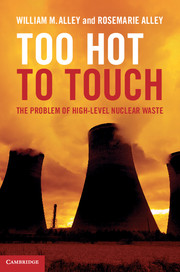Book contents
- Frontmatter
- Contents
- Acknowledgments
- List of units
- List of abbreviations
- Introduction
- Part I The problem
- Part II The mountain
- 12 The search for a geologic repository
- 13 Nevada wins the lottery
- 14 The Nevada Test Site
- 15 Yucca Mountain
- 16 How long is long?
- 17 Leaving almost no stone unturned
- 18 Surprise
- 19 Shake & bake
- 20 The project gets into hot water
- Part III No solution in sight
- Appendix Discussion questions
- References
- Index
16 - How long is long?
from Part II - The mountain
Published online by Cambridge University Press: 05 February 2013
- Frontmatter
- Contents
- Acknowledgments
- List of units
- List of abbreviations
- Introduction
- Part I The problem
- Part II The mountain
- 12 The search for a geologic repository
- 13 Nevada wins the lottery
- 14 The Nevada Test Site
- 15 Yucca Mountain
- 16 How long is long?
- 17 Leaving almost no stone unturned
- 18 Surprise
- 19 Shake & bake
- 20 The project gets into hot water
- Part III No solution in sight
- Appendix Discussion questions
- References
- Index
Summary
I have never, I think, in my life,
been so deeply interested by any geological discussion.
I now first begin to see what a million means.
Charles Darwin in a letter to James CrollModern Homo sapiens, with our great big brains, are really something special. We have walked on the moon. We have peered into the smallest particles of matter. We have developed vaccines and unbelievable technology. Our weapons have moved way beyond wooden clubs. We reason. We create. Yet, when it comes to dealing with time, we haven't changed much over the eons. We don't think or plan too far ahead. We have the ability to imagine the near future, yet when that time arrives it's so different from what we thought it would be. We do somewhat better with looking back and remembering past events, yet in the span of a lifetime our memories of childhood recede into an impressionistic haze. Without effort, most of us have a hard time remembering what we did two days ago. Like it or not, Homo sapiens mainly inhabits the present tense.
For many thousands of years our ancestors created an historical record in written and pictorial forms, yet these glimpses into the past have little meaning and no appreciable effect on our daily lives. Any child studying for a history exam will tell you that. Neil Chapman and Ian McKinley, eminent European geologists in the field of nuclear waste disposal, aptly stated the problem: “A pragmatic approach to time-scales would be that if you can really imagine what it would be like at that time, it is meaningful – if not, forget it. Computer models will happily predict releases after the expected lifetime of the Earth.”
- Type
- Chapter
- Information
- Too Hot to TouchThe Problem of High-Level Nuclear Waste, pp. 233 - 250Publisher: Cambridge University PressPrint publication year: 2012



